
Norman Graham Hill was a British racing driver and team owner, who was the Formula One World Champion twice, winning in 1962 and 1968 as well as being runner up on three occasions. Despite not passing his driving test until 1953 when he was already 24 years of age, and only entering the world of motorsports a year later, Hill would go on to become one of the greatest drivers of his generation. Hill is most celebrated for being the only driver ever to win the Triple Crown of Motorsport, an achievement which he defined as winning the Indianapolis 500, the 24 Hours of Le Mans, and the Formula One World Drivers' Championship. While several of his peers have also espoused this definition, including fellow F1 World Champion and Indy 500 winner Jacques Villeneuve, the achievement is today most commonly defined as including the Monaco Grand Prix rather than the Formula One World Championship. By this newer definition, Hill is still the only driver to have ever won the Triple Crown, winning at Monaco with such frequency in the 1960s that he became known as "Mr. Monaco". Hill crashed at the 1969 United States Grand Prix and was seriously injured, breaking both his legs and ending his season. Although he would recover and continue to race until 1975, Hill's career would never again reach the same heights, and the Monaco Grand Prix victory earlier in 1969 would be his last victory in Formula One.

The 1972 South African Grand Prix, formally the Sixth AA Grand Prix of South Africa, was a Formula One motor race held at Kyalami on 4 March 1972. It was race 2 of 12 in both the 1972 World Championship of Drivers and the 1972 International Cup for Formula One Manufacturers. The 79-lap race was won by McLaren driver Denny Hulme after he started from fifth position. Emerson Fittipaldi finished second for the Lotus team and McLaren driver Peter Revson came in third.

The 1974 Spanish Grand Prix was a Formula One motor race held on 28 April 1974 at the Circuito Permanente del Jarama near Madrid, Spain. It was race 4 of 15 in both the 1974 World Championship of Drivers and the 1974 International Cup for Formula One Manufacturers.

The 1974 United States Grand Prix was a Formula One motor race held on October 6, 1974, at the Watkins Glen Grand Prix Race Course in Watkins Glen, New York. It was race 15 of 15 in both the 1974 World Championship of Drivers and the 1974 International Cup for Formula One Manufacturers.

The 1975 Spanish Grand Prix was a Formula One motor race held at Montjuïc circuit on 27 April 1975. It was race 4 of 14 in both the 1975 World Championship of Drivers and the 1975 International Cup for Formula One Manufacturers. It is one of the most controversial and tragic race weekends in the sport's history after the death of four spectators who were hit by the crashing Hill GH1 of Rolf Stommelen. It was also the race in which Lella Lombardi became the first and so far only woman to score points towards the World Championship and future world champion Alan Jones made his first start.

The 1975 Belgian Grand Prix was a Formula One motor race held at Zolder on 25 May 1975. It was race 6 of 14 in both the 1975 World Championship of Drivers and the 1975 International Cup for Formula One Manufacturers. It was the 33rd Belgian Grand Prix and the second to be held at the Circuit Zolder. The race was held over 70 laps of the four kilometre venue for a race distance of 280 kilometres.
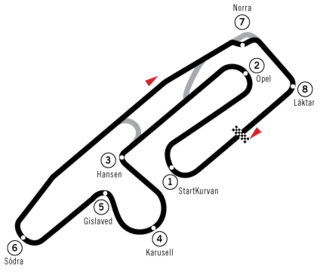
The 1975 Swedish Grand Prix was a Formula One motor race held at the Scandinavian Raceway at Anderstorp on 8 June 1975. It was race 7 of 14 in both the 1975 World Championship of Drivers and the 1975 International Cup for Formula One Manufacturers. It was the sixth Swedish Grand Prix after it was first held as the Swedish Summer Grand Prix in 1933, and the third to be held at Scandinavian Raceway. It was held over 80 laps of the four kilometre circuit for a race distance of 322 kilometres.

The 1975 Italian Grand Prix was a Formula One motor race held at Monza on 7 September 1975. It was race 13 of 14 in both the 1975 World Championship of Drivers and the 1975 International Cup for Formula One Manufacturers. It was the 45th Italian Grand Prix and the 41st to be held at Monza. The race held over 52 laps of the five kilometre circuit for a race distance of 300 kilometres.
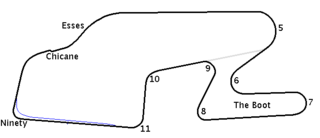
The 1975 United States Grand Prix was a Formula One motor race held on October 5, 1975, at the Watkins Glen Grand Prix Race Course in Watkins Glen, New York. It was race 14 of 14 in both the 1975 World Championship of Drivers and the 1975 International Cup for Formula One Manufacturers. It was the 25th United States Grand Prix since the first American Grand Prize was held in 1908 and the 18th since the first United States Grand Prix at Riverside in 1958.
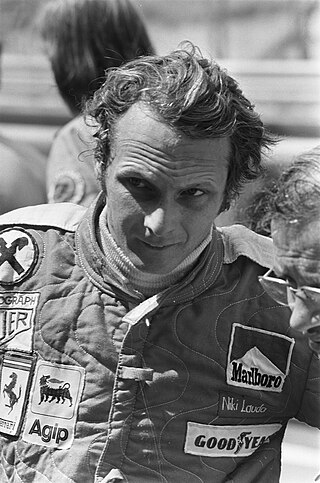
The 1975 Formula One season was the 29th season of FIA Formula One motor racing. It featured the 1975 World Championship of F1 Drivers and the 1975 International Cup for F1 Manufacturers which were contested concurrently from 12 January to 5 October over fourteen races. The season also included three non-championship Formula One races and a nine race South African Formula One Championship.
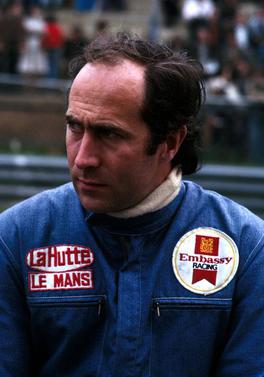
François Migault was a racing driver from Le Mans, France. He participated in 16 Formula One World Championship Grands Prix, debuting on 13 August 1972, but scored no championship points.

Anthony William Brise was an English racing driver, who took part in ten Formula One Grand Prix events in 1975, before dying in a plane crash with Graham Hill.
Embassy Racing With Graham Hill, commonly abbreviated to Embassy Hill, was a short-lived Formula One team started by two-time Formula One World Champion Graham Hill. The team debuted in 1973 with a customer Shadow DN1 car, and began racing as a constructor with its own chassis in 1975. The team had limited success in three seasons of racing, but everything was cut short by the death of Hill, Tony Brise and some of the team's top personnel in the crash of a light aircraft in the autumn before the 1976 season. The team was sponsored by Imperial Tobacco's Embassy cigarette brand and ran under various names during its time.

The Montjuïc circuit is a former street circuit located on the Montjuïc mountain in Barcelona, Catalonia, Spain. The circuit was also the venue for the Spanish motorcycle Grand Prix from 1950 to 1968, and then hosted the event on even-numbered years until 1976. The last Formula One Grand Prix held there in 1975, is notable for both a fatal crash that led to Formula One abandoning the venue and the only occasion to date that a female driver has scored World Championship points.

The Wolf WR7 was a Formula One car built for the 1979 season by the Walter Wolf Racing team. Three examples of the car were produced. The first was WR7. A second car, WR8, was built to the same specification, while a slightly modified car, WR9, first appeared at the British Grand Prix. The cars were driven by 1976 champion James Hunt and Keke Rosberg. The engine was a Ford Cosworth DFV.

The 1971 Argentine Grand Prix was a motor race consisting of a Formula One class and a Formula 5000 class, held at the Buenos Aires circuit in Buenos Aires on 24 January 1971. The Formula One class was not part of the FIA Formula One World Championship.
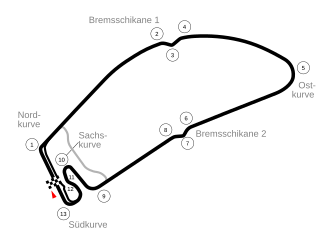
The Jochen Rindt Gedächtnisrennen or the VI Rhein-Pokalrennen was a motor race, run to Formula One rules, held on 13 June 1971 at the Hockenheimring, Germany. The race was run over 35 laps of the circuit, and was dominated by Belgian driver Jacky Ickx in a Ferrari 312B.

The Lola T370 was a Formula One car designed by Andy Smallman and used by Embassy Hill in the 1974 season and the early part of the 1975 season. After an unsuccessful 1973 with a customer Shadow DN1, the Embassy Hill team commissioned its own cars from Lola. The T370 was largely based on Formula 5000 designs, and looked similar to Lola's F5000 cars, although it sported an extremely large airbox. Embassy Hill had two cars for Graham Hill and Guy Edwards. The car was tested well before the end of 1973 in readiness for the January start to the 1974 season.

The BRM P201 is a Formula One racing car built by British Racing Motors and designed by Mike Pilbeam, which raced in the 1974 and 1975 seasons and in P201B specification in 1976 and 1977. The P201 featured a triangular monocoque, hip-level radiators, outboard front springs and inboard brakes. It used a 3.0-litre V12 engine and competed in 26 races, making 36 individual entries in total. Its best finish was second place for Jean-Pierre Beltoise at the 1974 South African Grand Prix, on the car's debut.

The Williams FW was a Formula One car used by Frank Williams Racing Cars during the 1973, 1974 and 1975 seasons. It was designed by John Clarke.


















